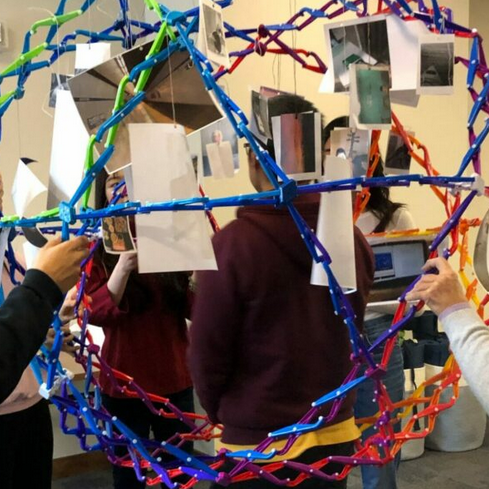Start Where We Are
Can your university experience be a time of flourishing?
How to Use Windvane
Caring for myself is not self-indulgence, it is self-preservation, and that is an act of political warfare.”
Audre Lorde,
A Burst of Light (1988)
First, we suggest that you explore this site’s resources. You could start with materials at Understand Suffering and Explore Wellbeing, but then we invite you to wander around and see what else piques your interest. All of us have suffered throughout our lives in myriad ways, and finding wellbeing is a project that we work on within our unique contexts, goals, preferences, and values. This is a project for you to do on your own and with your own community. We do not offer you a single path, but rather a selection of tools and ideas that will help you develop your own paths.
Although working on your health is an individual project, it’s critical to know how wellbeing and suffering occur in the context of our social, cultural, and political circumstances. Studying
different approaches to wellbeing can help us see what may be within our individual control now, and when we may need to take community action to address forces that are systemic. One of Windvane’s roles is to help you
learn a bit about these intricacies. Windvane contributor
Dr. Kate Mulligan has worked a lot on the issue of what are called the social determinants of health. In
COVID-19 and Health Equity for Marginalized Populations, an April 2020 Webinar, for example, she explains how the pandemic has affected communities differently. The the COVID-19 pandemic is affecting not only individuals’
health, but a whole interconnected web of social, environmental, economic, and political dimensions.
Developing Your Own Plan for Wellbeing
We first need to identify what we value and need as part of our daily lives, as well as how social, cultural, or political factors are affecting us. As we take stock of these various influences on our situation, we can start to understand how to direct our efforts toward maintaining a stable level of wellbeing.

Then, we can also begin thinking of strategies to employ if there is a crisis, or if we begin to feel overwhelmed and stressed.

Write out your plans in a notebook or a note card you can carry with you, or create a drawing or schematic that represents what wellbeing means to you and what path you want to take.
Taking stock of our various contexts
We all live within social and cultural contexts, and these factors can influence our opportunity for wellbeing, either empowering or diminishing us.
Stress and anxiety can result from a whole range of structural issues, such as chronic health or disability, family or relationship conflicts, isolation and lack of social support, financial problems, academic challenges,
or past or present experiences of physical, sexual, and/or emotional abuse. Other structural factors may include experiences of racism, ableism, sanism, homophobia, transphobia, sexism, ageism or xenophobia. Knowing
how these systemic factors operate in our lives can help us understand what kinds of supports and practices to put in place to work toward improving our circumstances over time.
Start by educating yourself on some of these critical factors, reviewing some Perspectives on Wellbeing and watching videos on this website. Which resources and videos stand out to you as insightful or relevant in your life? Think about how your path to wellbeing might be restorative, and how it could be empowering, community-oriented, and/or responsive to histories, cultures, and places.
What does wellbeing mean for you?
After you’ve done some research on this site and elsewhere, try to write out or draw what it means for you to be well. Making our thoughts into something visual can help us organize and understand our views more clearly. When we see a depiction of what we think, we can feel how accurate this depiction really is or isn’t. Take a look at some examples of how different communities have depicted domains of health or wellbeing. Does one of these especially appeal to you, or would you want to combine some of these ideas to create an image that works best for you?
What’s going right for you now?
You might next work on identifying what you do now to integrate suffering or stress in your life. The University of Buffalo School of Social Work’s Self-Care Starter Kit may be helpful. Their Self-Care Assessment form will help you look more deeply at the good things you are already doing for yourself and address any imbalances in the areas where you practice wellbeing. This assessment can also help you to identify the effective coping strategies you currently use. Their Lifestyle Behaviors survey can help you think about what components of your lifestyle might be causing you stress. Then you can think about what is and isn’t having a positive impact on your wellbeing.
Or, you may want to use your own depiction of how various elements of wellbeing are functioning in your life, perhaps modeled after the Medicine Wheel or the Ten Domains of Wellbeing. You can include whichever factors make most sense to you in your life right now.
This exercise can also be used to think about additional ways to prevent stress from building up in the future. Notice which activities your feel drawn towards and want to add to your daily practice. Try to ensure you are choosing items from across different domains of self-care. Feel free to add other things you might think of – this is totally individual to your own life.
Routine self-care: Maintaining helpful practices and eliminating obstacles
“Routine self-care” refers to activities that are most important to you and that you have committed to engage in on a regular basis. The UB My Maintenance Self-Care Worksheet provides a framework for you to identify the activities you would like to add to your practice. Or, you can use your own drawing, integrating the different domains that are important to you. Do you want to consider trying out some of the Windvane practices?
Don’t forget to identify possible obstacles you may encounter in trying to implement a new routine or maintain an existing one. Try to list 3 or 4, along with methods for overcoming them and reminders to help you stay on track. You can think of helpful methods in terms of Windvane’s three areas of cultivation: attention, embodiment, and interconnection.
Event-responsive and emergency self-care: Being prepared
Planning out what to do after a really hard event, under trying circumstances, or in the case of a period of extreme suffering is an important addition to a regular wellbeing practice. What are some things you can do for
yourself when something hard has happened, like a poor grade in a course or a relationship conflict? Make a list of some of these practices and keep it handy for when you need it.
You can check out the UB Emergency Self-Care worksheet to make a plan before you are faced with a crisis, should one ever arise. By making an emergency plan while we are in a stable frame of mind, we ensure that qualities of wellbeing can be made available to us during times of distress. If your emergency plan isn’t enough, there are always more resources to help you through hard times.
Make a commitment to yourself
You deserve to care for yourself. You deserve to prioritize feeling well and being ready to be your best self at work, school, and in relationships. We cannot bring our full potential into the world if we do not first ensure that that potential is being nurtured and sustained.
If you find it challenging to make this commitment, take some time to explore your hesitancy. Maybe you are used to putting the needs of others before your own. Seeing that your own wellbeing is also a way of caring for others is an important step in allowing time for “putting ourselves first” – we put ourselves first so that we can serve our communities and live by our highest values.
Share your plan
Our social connections can be important resources in exchanging self-care ideas and strategies. Telling people about your aspirations can also help you to feel supported and encouraged.
Consider taking your commitment a step further by bringing others into the conversation (see Tips for Starting a Support or Discussion Group).
Follow your plan
Having completed the above, you have now identified the core elements of your personal plan for wellbeing. Now, the final step is to implement your plan and keep track of how you are doing. Keeping a record of how each day or week goes can help you recognize places where you live up to your goals and areas where you met unexpected challenges. The idea is not to criticize yourself harshly if you do not meet your goals, but rather to just apply more mindfulness around these areas and continue along the path. You’re doing great!
